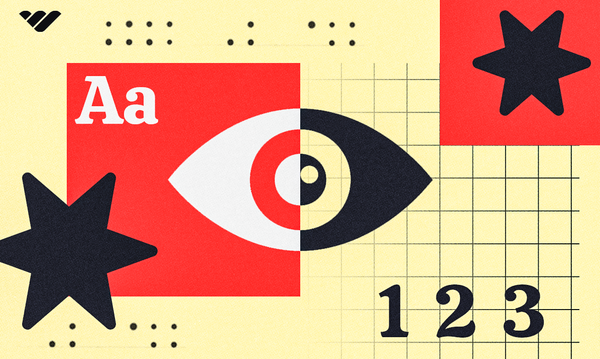If there's one thing most digital creators have in common, it's that struggle of having to name a price.
You probably know that feeling of: "It's too much. I need to charge less, or people won't buy it." But what if I said that you could make much more money by simply charging more?
All you need is a high-ticket offering. Whop creators like you increased their revenue significantly by creating highly tailored products that their customers needed—and getting paid accordingly.
How do you launch a high-ticket offering, and why is it absolutely worth your time? I'll walk you through it below and help you earn even more money with your whop.
What is a High-Ticket Offering?
A high-ticket product (aka offering) is a product that's usually priced at above $1,000 - but that doesn't make it overpriced. Instead, high-ticket offers are highly personalized and filled to the brim with value.
It's not as simple as bundling a few of your products or services together. When you launch a high-ticket offering, it has to be something that closes the gap between you and your audience. It's a more intimate, but also more effective experience that comes with measurable impact and tangible results.
The exact nature of your offer will depend on your product, but in general, try to think of something that's interactive, useful, and significantly better than low-ticket offers. It also doesn't need to be just one product—it can be a bundle of services and products that all work together to create something awesome.
Some examples of what you may call a high-ticket product include:
- Mentorship programs
- Exclusive masterminds
- Small, tight-knit communities of experts and enthusiasts
- One-on-one coaching
- Specialized courses
- Resources that are unavailable to your other customers, such as exclusive software, templates, or ebooks
Notice what all of those things have in common? They're aimed at small groups of people. This is because the goal is not to appeal to as many people as possible, but rather to create something where the price matters less than the value.
Your target audience is narrowed down to the customers who truly want to learn or improve, so they're willing to pay extra for an exceptional product or service. That's where you come in!
4 Reasons to Launch a High-Ticket Product
Switching to a high-ticket product certainly means stepping out of your comfort zone, so why even do it? It's simple: this is one of the best ways to make more money and become more successful without letting it rule your entire life.
We don't just have faith in high-ticket products—we know for a fact that they work, and they work well. Launching a high-ticket offer is now part of your Whop Dashboard for a reason. You'll find it under Growth Hacks, alongside things like 'joining the marketplace' or 'setting up cancelation discounts'. It's just that effective.
Let's take a quick look at some of the reasons why you should explore high-ticket offerings.
You can increase your revenue
I know what you must be thinking. Well, duh. Of course, if you charge $1,000 and above for each sale, you're going to make more money, right?
But it's not quite that simple, and many creators undervalue themselves in the fear of driving customers away. Following the beaten path and keeping your prices conservative feels safer for a reason.
I'm not here to lie to you. It's true that most people won't shell out $1,000, $2,000, or $5,000 on just about any service, but the trick is that it's perfectly fine if they don't. You're not trying to appeal to most people, but rather to a select few who are looking for the best of the best you have to offer.
High-ticket offers result in higher revenue and an increase in average user lifetime value (LTV). Our creators noticed that increasing their GMV boosted their revenue significantly.
With some time and a touch of clever marketing, that could be you too.
Your customers will care more
This ties in with my previous point. Put yourself in your customers' shoes for a second and imagine that you're buying a course and paying $20 for the whole thing.
What are the chances that you'll actually go through and complete it, learning something useful in the process? It's easy to set it aside and sacrifice that $20 if you don't have the time or energy to go through it all.
Now, imagine that you're buying something extraordinary from someone who is an expert in their niche. It costs you $1,500, but you're getting personalized tips, frequent communication, check-ins, motivation, and help if you're ever stuck.
Is it worth it? Absolutely, and people appreciate that. Perceived value is a powerful thing, especially when it's backed by actual value.
Our data shows that the average customer LTV increases if you're selling high-ticket products. This is because your customers respect you and are willing to invest in your future content. They already trusted you once and they know you're worth another investment. Upselling and retention become easier with high-ticket customers.
In short, spending more money means caring more, and that helps a lot, resulting in higher customer satisfaction, lower churn, and a more engaged audience.
You can stop spreading yourself thin
There are lots of benefits to running your own business, from the flexibility to the ability to put your thoughts and ideas to work. But entrepreneurs are at a high risk of burnout, and selling themselves short is part of the problem.
If you're constantly juggling many different products or services, you've got your plate full and then some. Selling them at low prices means that you constantly need to get more sales, and it becomes a never-ending cycle of creation, marketing, and price adjustment.
By managing a single high-ticket product (sometimes alongside a couple of cheaper offerings), you can save both your time and your sanity. You'll focus on working with a smaller customer base, which makes it easier to tailor your products to their needs. And, while you’ll still need to keep up with the cycle of creation and marketing, it’ll be spread over a much longer period of time.
You can grow your business
Scaling your business is challenging, but selling high-ticket offerings helps you take bigger strides at a time.
For starters, you're getting higher profit margins. More than that, each sale adds a nifty sum to your bank account. This makes it easier to reinvest that money back into your business, driving customer acquisition.
Customer acquisition is a different experience, too, because not only do you need fewer sales to turn a good profit, but you also can run highly targeted marketing campaigns. You're aiming to appeal to your ideal customer, which makes marketing more straightforward. The sales process is more focused, although it does require more nurturing and a very personal touch.
Building a brand becomes easier when you're focusing on your expertise to the extent that's needed for this type of marketing, too. You position yourself as an expert by having the confidence to ask for more, and that puts your business in a league of its own. It's a good stepping stone toward even greater growth.
The Power of High-Ticket Offers: Success Stories
High-ticket offerings truly do the job for many creators, but it's one thing to say it and another thing to see it for yourself. That's why we’re going to introduce you to three Whop creators who went all-in on high-ticket offerings and saw their businesses soar as a result.
The real-life examples you'll see below are all successful Whop sellers. These are entrepreneurs like you who saw the power of high-ticket offers for themselves.
TJRTrades
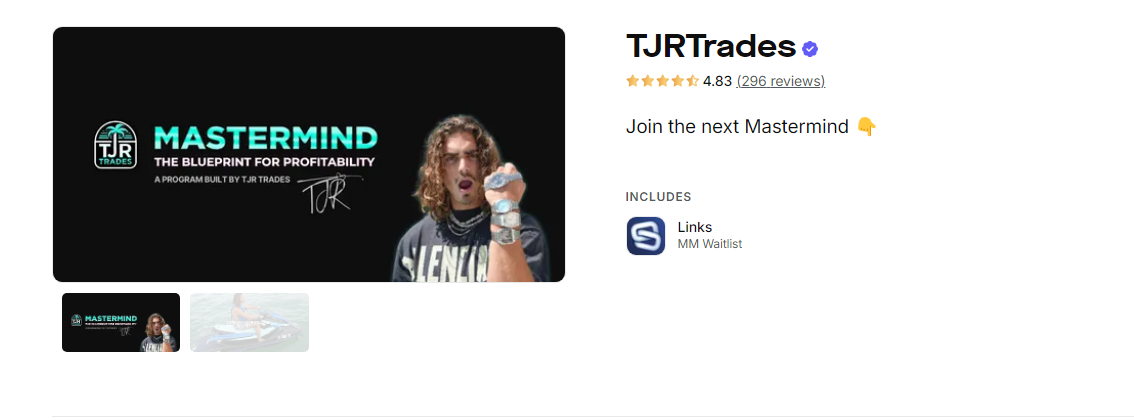
TJRTrades is a trading community of more than 3,700 people, and it’s run by Tyler, a highly experienced trader. That community is now evolving into a mastermind that Tyler himself refers to as “the blueprint for profitability.”
Within the mastermind, TJRTrades offers:
- Over 20 hours of live, personalized Zoom sessions, complete with recordings that remain available 24/7 after the meet-up
- Lifetime access to the Premium side of the TJRTrades Discord server, which is now the only way to join it
- A $100k funded account that members can learn to trade on and eventually make money from directly
- An exclusive community made up of real traders, including TJR, for mentorship and brainstorming sessions
TJRTrades is very clear on one thing: His mastermind is not for everyone. He’s looking for dedicated members who are willing to give up nights out and really focus on their training. This goes to prove that your product doesn't need to be aimed at everyone—it just needs to be tailored to those with specific needs instead.
Stock Dads
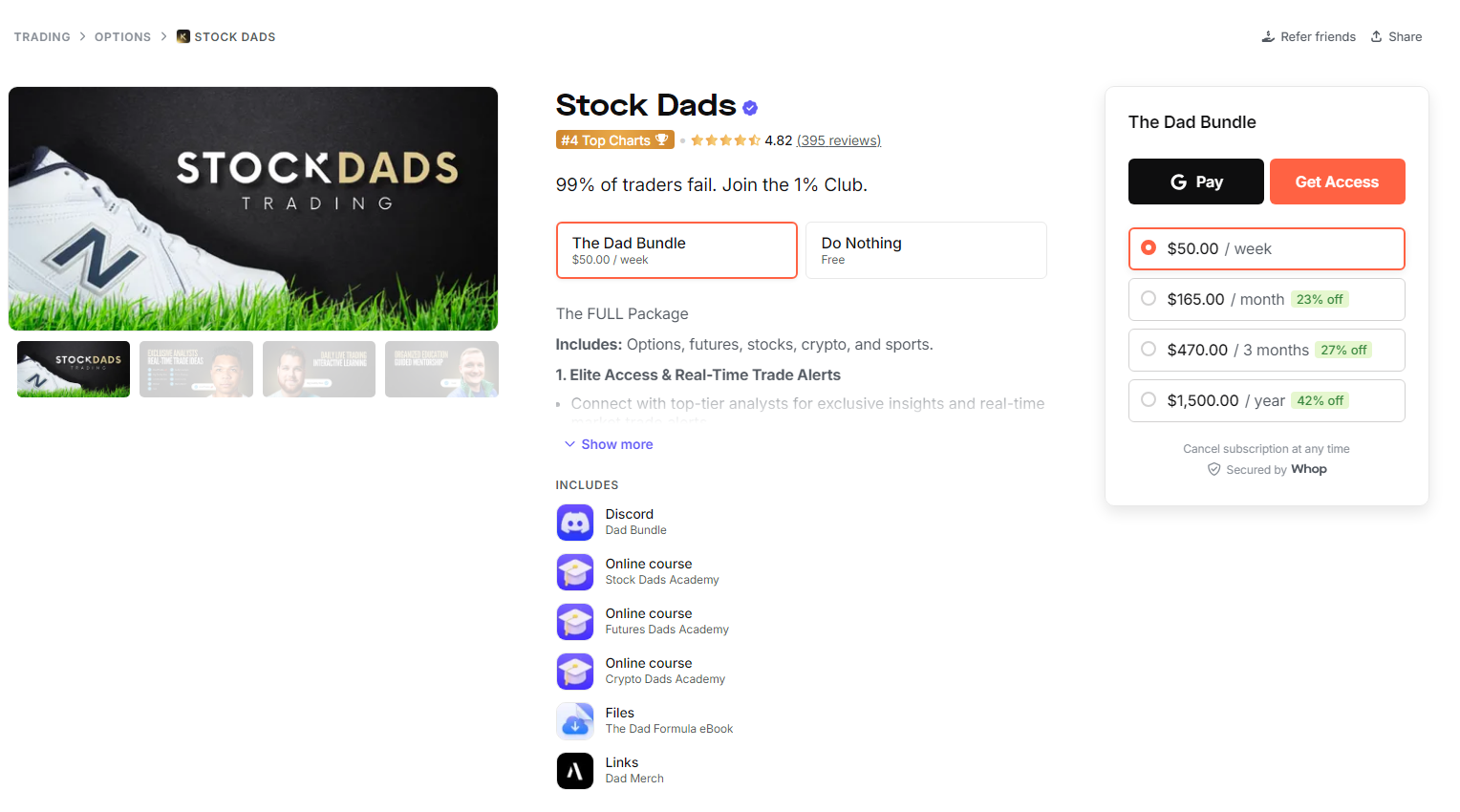
Stock Dads is more than just one person—it’s a whole group of mentors who know everything there is to know about finance, including options, futures, crypto, stocks, and even sports betting.
By putting together a team of recognized experts in the field, Stock Dads are able to offer a unique mentorship experience. This is easy to see from their offerings.
You can subscribe to Stock Dads, which costs up to $1,500 a year, to get access to:
- Real-time trade alerts
- Exclusive access to top-tier analysts
- Daily trading sessions
- Video courses
- Mentorship and guidance, including consultations with a CPA, CFP, and other licensed professionals
- Incredible networking opportunities
- Ebooks
This is just one part of it all, though. Stock Dads now also offer an exclusive mastermind, where Big Daddy Max will teach a select group of people everything he knows about options selling and futures trading.
Media Labs
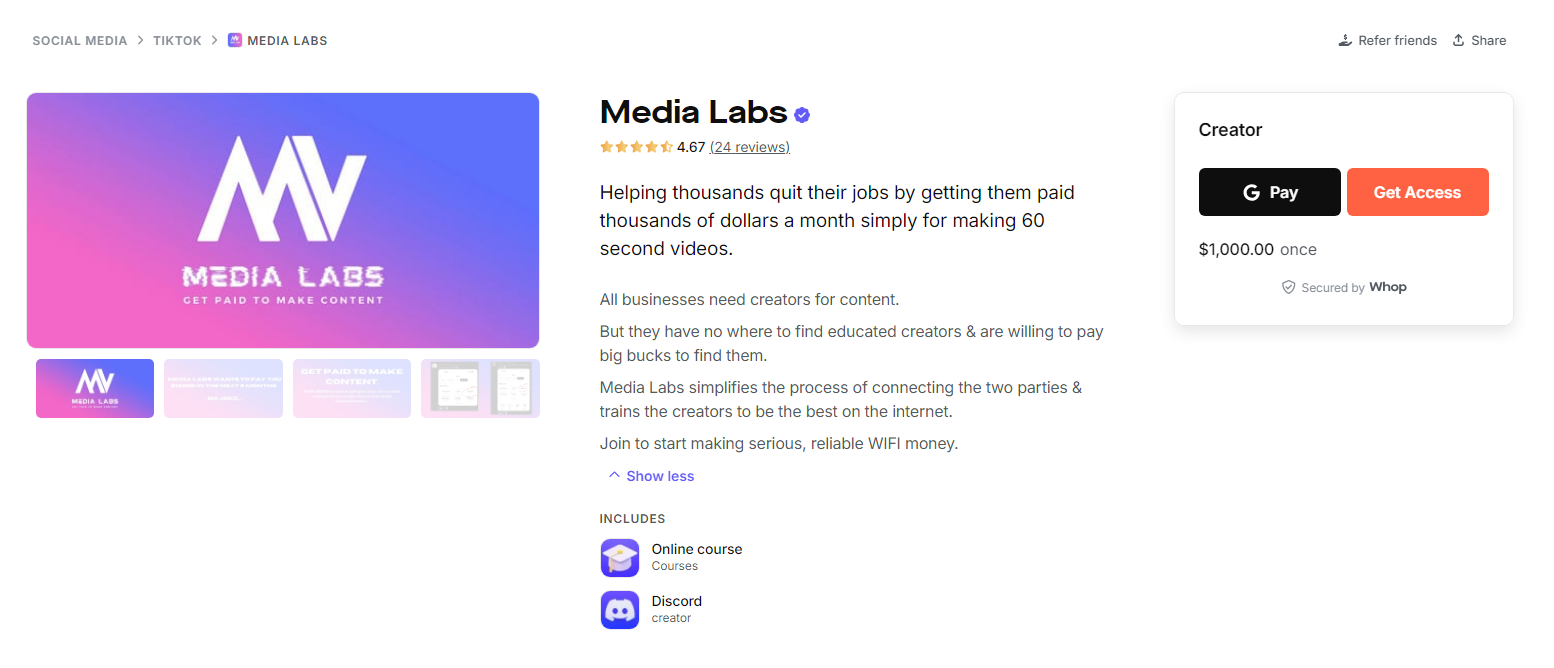
Traders aren’t the only entrepreneurs who can make big bucks on high-ticket products. Media Labs, a Whop creator in the social media space, teaches people how to make a living off of making 60-second videos. They’re effective enough that their users are more than willing to pay a one-time fee of $1,000.
Media Labs doesn’t just provide its customers with incredible value through courses. It’s also a bridge between creators and companies, offering instant access to businesses that are willing to shell out good money on retainers for the right person.
This isn’t something that everyone gets to do, though. Like other high-ticket businesses on our list, Media Labs asks for a lot from its customers, and gives a lot in return. As a result, users need to first pass the Media Labs Creator Brief course to be able to connect with leads.
Instead of going for cheap offerings, Media Labs backs up their expertise with a ROI guarantee. The customers who don’t make all of their $1,000 back within the next 90 days can have the difference refunded. This type of confidence and exclusivity can both get you leads, and from all the right people, too.
Those are just some of the success stories we've seen on Whop. The next one could be yours. Tangible results, an increase in revenue, and unparalleled growth are all ripe for the taking.
Design Your High-Ticket Offer in 5 Steps
Are you ready to design your first high-ticket offer and start making more money?
Below, you'll find our 5-step high-ticket blueprint that will take you from ideation to creation.
1. Pick a product
Your first step is to pick the product you want to brand (or rebrand) into a high-ticket offer. Remember that it needs to be something that you can make fully your own and personalize to the needs of your exact audience.
Start by thinking about how your idea fits into the high-ticket narrative. Let's say that most of your products are much cheaper than your target price right now.
What would you have to do to get your community to pay a ton more? What's going to be worth it to them?
Your ideal product is something that heavily leans into your status as an expert. You're not just a business owner—you're a thought leader, an entrepreneur, and a person who knows the topic in and out. You're offering a highly personalized experience to a select group of people, and those people are getting something exclusive that they couldn't get anywhere else if they tried.
Moreover, it's not a one-and-done sort of thing. High-ticket products come with heaps of up-to-date information, accountability, and ongoing help. They're a commitment, both for you and your audience.
The products that best lend themselves to high-ticket offers include:
- Masterminds, which are a small group of people who meet up frequently to trade insights and work toward their goals. Mastermind groups can meet either online or in person, and the meetings tend to be frequent to make them worthwhile. Every member of the group needs to be thoroughly vetted—money alone shouldn’t be enough to get someone in a mastermind group.
- High-value courses with a student community. These are courses that go above and beyond to help their students learn something useful. It's not just sharing course material, but also adding check-ins, quizzes, and personal assistance. Most of all, the course comes with a private community just for the students and you (as well as any other mentors).
- One-on-one coaching. In this scenario, you're working directly with each customer and helping them achieve their goals, be it trading portfolio growth or weight loss. As a private coach, you don't just provide video calls. You set up personalized plans and oversee the progress of every customer every step of the way.
- Small group mentorship. This is different from a mastermind—it's more like taking a class that has one mentor and a handful of other students. You'll support the entire group during regular meetings, but you'll also foster a collaborative environment where every person benefits from working alongside others.
Think about how these types of products fit your niche. Your next step is to decide on the specifics.
2. Build your offer
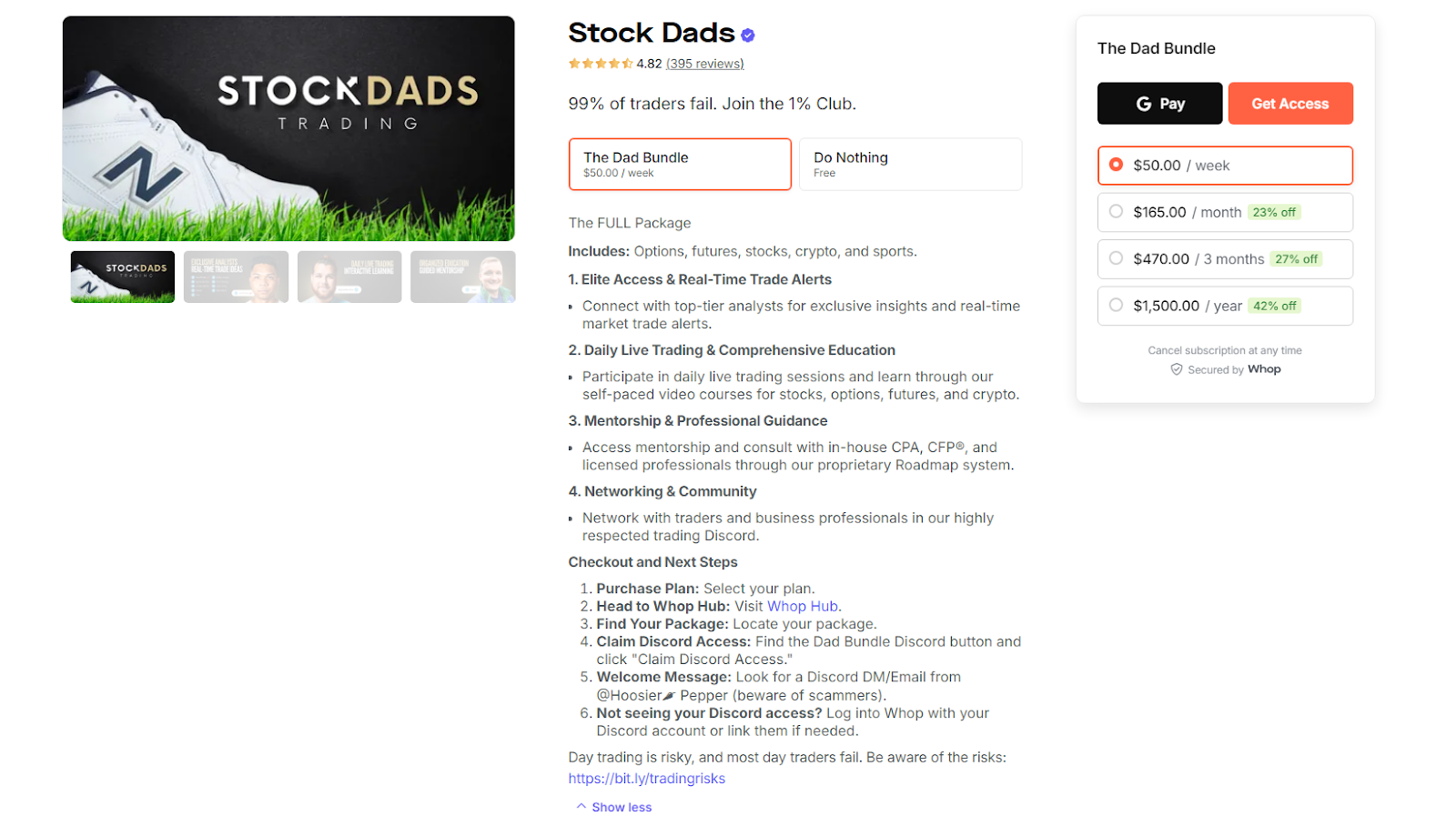
Building your offer is all about fleshing out what you're going to provide.
Since you're selling a high-price, high-value product, this planning stage is crucial to its success. You want your customers to feel like you've addressed their every question and every need—that's going to make them feel secure enough to shell out a lot of money on your offering.
Here are some key things to keep in mind as you work on this step:
- Prepare a comprehensive overview of your product. Check out the way Stock Dads on Whop, which charges $1,500 a year, handled this step. Everything is neatly outlined so that the customers know what they're getting, how often, and with whom.
- Define the program structure and set clear expectations, including the key components of your offer.
- Live mastermind sessions are the backbone of many high-ticket offerings. No matter the nature of your product, it's a good idea to bundle this into your offer, giving your community a chance to speak to you—and to each other.
- Is your product focused on one-on-one work with you, or are you selling access to a community of like-minded experts? What will that look like?
- What are your direct competitors offering, and what can you do to be better than them?
At this initial planning stage, it's important to dive into market research and try to find out what your audience wants. It's often as simple as asking them. You can also look through your Whop Dashboard or tools like Google Analytics, but asking your customers directly is a great way to find out.
This can be done in a number of ways:
- Ask them on your social media profiles
- Run a survey
- Set up a Q&A and ask them during a live event
- Set up an anonymous form for them to fill out—this is good because you might get more information, including demographics and goals
End this step with a complete overview of your high-ticket offer.
3. Set the price and timeframe
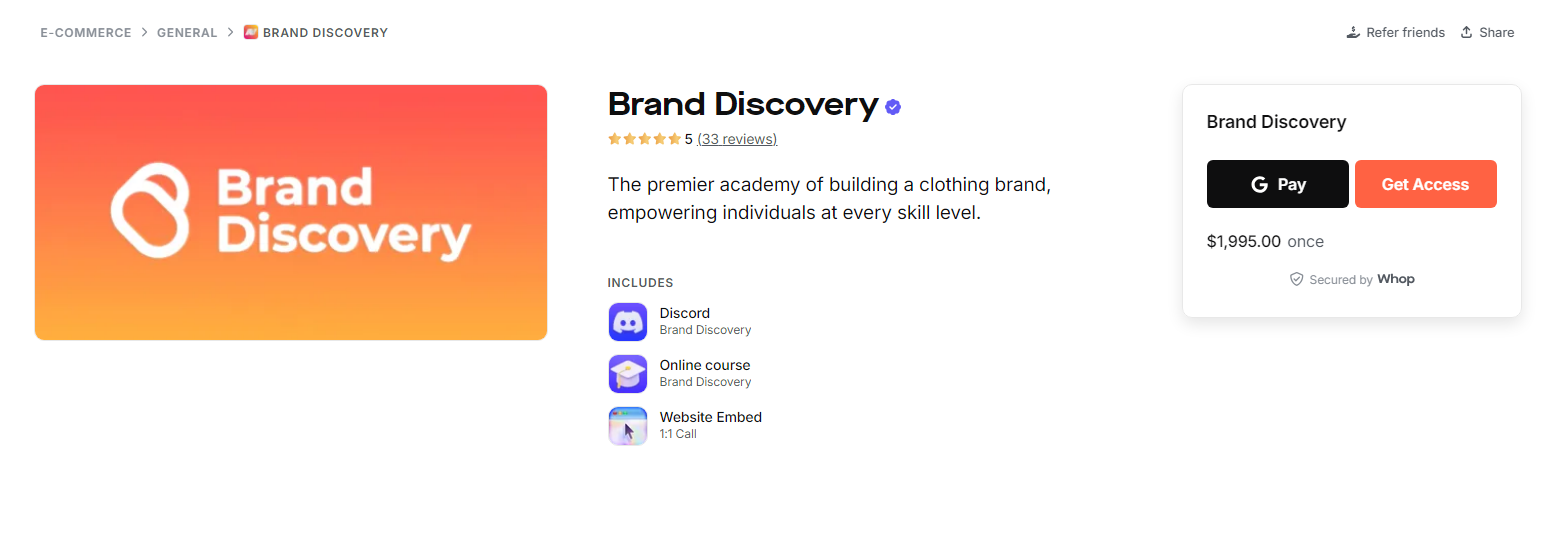
Time for an exciting, but also (admittedly) mildly scary step: set your price and decide on a launch timeline. This is where you commit to your high-ticket offer and price it accordingly.
This part is not unlike pricing any other digital product. First, decide between different pricing strategies. Creators on Whop usually use one of the two:
- One-time payments, such as Brand Discovery or Media Lab
- Subscriptions, including payment options like:
- once a week
- once a month
- once every three months
- once every six months
- once a year
Short subscriptions are a good way to make your product more accessible while keeping it high-ticket. On the other hand, you might miss out on the exclusivity that comes with having to pay a large amount of money upfront.
Tiered pricing is another thing to look into. You don't have to ditch your low-ticket products just because you're launching something big. In fact, they'll come in handy in step 5, so sit tight!
Most exclusive high-ticket offers are priced between $1,000 and $4,000. This can be a flat fee or a yearly fee, but starting around this ballpark is a good idea. If your product can deliver incredible value, you might be able to charge even more.
Now, the timeline. Approach the next part of this as if you were writing a business plan, because hey, you pretty much are! Most masterminds, personal mentorship programs, and courses run for 4 to 8 weeks. Plan out how long your product is going to run for, and stick to it.
There are certain features you can keep up after the main event ends, such as Q&A sessions or the community that you’ve built, but the bulk of your product will come to an end after a while. It’s up to you to decide how long you and your customers need to walk away fully satisfied.
Set a firm launch date only once you've planned out all the pre-launch preparation and you're feeling confident that you can meet that deadline without a hitch. Plan out a launch sequence, from the initial marketing efforts to things like hosting a celebratory virtual event for your new customers.
4. Create an agenda
You know what your product entails and how much it's going to cost. It's time to narrow it down to the minute details and create a full-on agenda.
- Specify your communications channels. How are you going to deliver announcements and updates to your community? How often will you release new content, and where? How will you send out event reminders?
- Where will you host your masterminds sessions, 1:1 calls, webinars, Q&As, and any other live sessions? Setting them up in the Events app on Whop is a great idea—it saves you the hassle of manually sending links to Zoom or any other platform.
- Speaking of masterminds, what's that going to look like? Think about concepts like hot seats, where participants take turns in being able to speak. It's hard to build a more collaborative environment than that. Take it a step further. Will you invite expert guest speakers?
- How will you record your sessions, and will the recordings be available later? Are you going to share some key takeaways from each session, and if so, where?
- The same goes for personal mentorship and coaching. How often will you host the meetings, and with how many people at a time?
- What kind of courses, video tutorials, templates, quizzes, and expert resources do you need to prepare ahead of your launch?
- Will you assign homework? How often will you look through it, and what kind of feedback will your customers receive?
- Will you create tests and quizzes, and how will you handle them if someone fails to pass them?
- Are you planning to host giveaways? (Pro tip: You should, and it's super easy with Whop)
Once the main framework of your agenda is all done, dig a little deeper. Many customers will expect you to run an exclusive community, so what does that really mean?
Think of adding things like:
- A "wins" channel where users can brag a little about their latest achievements
- An accountability channel where you and the rest of the community can help others stay motivated. You can even set up accountability partners or progress-tracking tools, such as templates.
- A channel for questions and/or getting help when needed
- A separate section for resources, unless you make them downloadable through your whop instead
At the end of this step, you should have a plan for everything that your high-ticket product contains, from the very foundation (such as whether it's a course or a mastermind group) to the tiniest details, such as the number of mods you might need for a Discord or Telegram server.
5. Plan out your marketing strategy
Congrats! You've got yourself a killer product and an agenda that would put even the most uptight planners to shame. Now, it's time to get your work the recognition that it deserves with a solid marketing strategy.
Much like the agenda, this should be a step-by-step process that covers all bases. Let's start from the top:
- Create a waitlist. This is the #1 way to build up the hype. Your product is exclusive—don't be afraid to say it out loud. Some of the biggest content creators set up massive waitlists before launching a new product.
Don't be afraid to say that not everyone who signs up for the waitlist will be allowed to buy your product. If you're angling for a small mastermind, this will just enhance the exclusivity aspect of it all and bring you closer to your target audience. - Start gauging interest. Whether you've already asked your customers for their thoughts or not, now is the time to let them in on the excitement. Soft-launch your product first with more (and then less) ambiguous teasers in your existing low-ticket community.
Use this phase to gather feedback on your upcoming product. You might get some good ideas on how to refine your offer even more. - Add contact forms to your low-ticket products. Set up a Typeform or a Calendly and build them into your existing products. This is a great way to start gathering leads from people who already liked your stuff enough to pay for it. This leads to pre-sales conversations and discovery calls, which help both sides discover whether you're a good fit.
- Create a landing page with a video sales letter (VSL). VSLs play a big part in driving sales and conversions. The goal is to clearly communicate the value of your high-ticket offer, but also to add that personalized touch that they're going to be privy to throughout their time with you. Tie it off with a strong CTA that gets them to either buy the product or get in touch with you to learn more.
- Start teasing your offer on social media. You know those "coming soon" posts that reveal virtually nothing and still manage to be exciting? Now it's your turn to be a little vague (in the best way possible).
- Maintain an air of exclusivity. For example, on Instagram, send out stories and posts only to your "Close Friends."
- Share behind-the-scenes content, sneak peeks, and testimonials.
- Lean into automation. Use chatbots like ManyChat, MobileMonkey, Twilio, Chatfuel, or Twitbot to automate your DMs and nurture leads.
We know that you're busy setting up your product, so if you can't find the time to handle your social media and sales, it's time to find a team to do it for you—and we know just the right people.
Grow Your Business With Whop
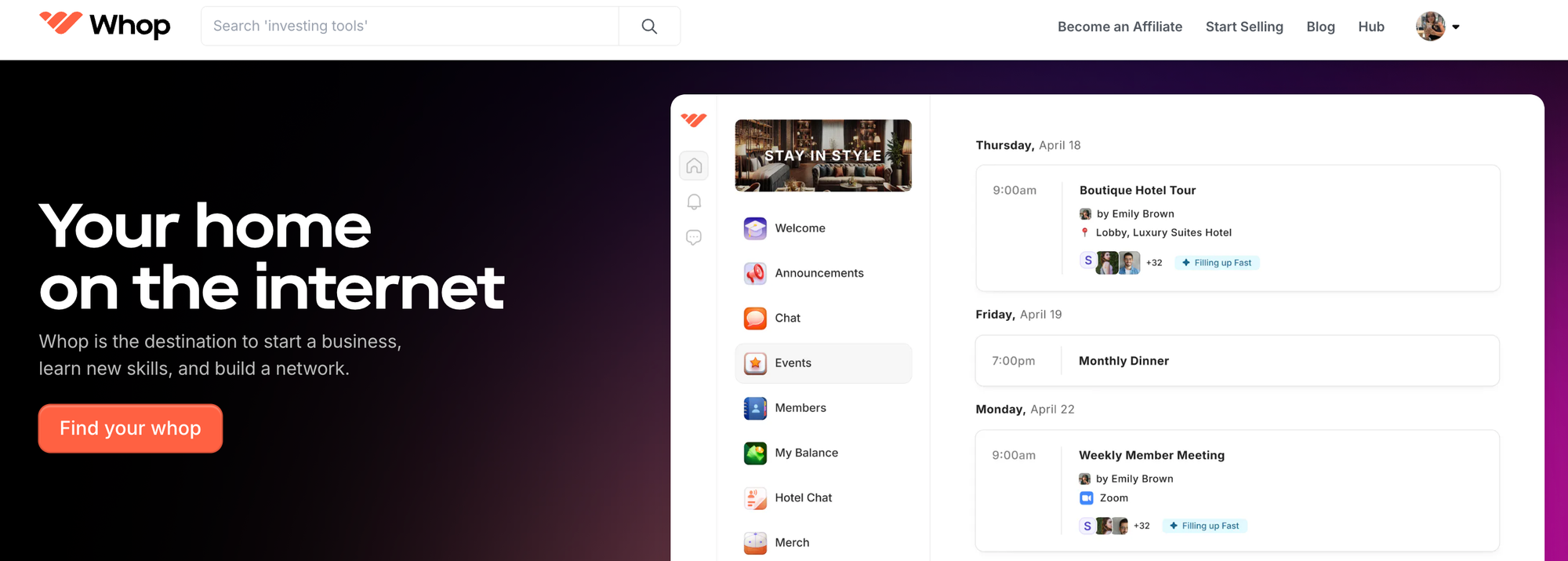
We know that taking a leap can be scary, but we also know that it pays off. High-ticket offers increase your revenue, and that's not a guess, a hunch, or a marketing pitch—it's a fact.
There will be an initial time investment, and even once your product is out there, you'll still need to keep up with your community and be there for them as they make the most of it. But with all that care, your product or service will flourish, and your business will grow right alongside it.
Happy customers who get to learn from you directly and receive the best support they can get are much likelier to come back to you and buy from you again. Before you know it, you'll build yourself an audience of highly engaged and receptive followers. There's no better place to be if you're trying to sell something.
Stop selling yourself short. Launch a premium product and get paid what you deserve. Set up your high-ticket product with Whop today.
Don't yet have a whop? Create one here!

